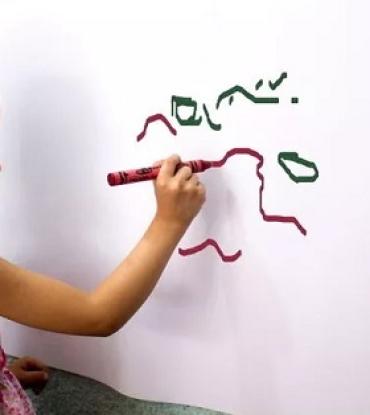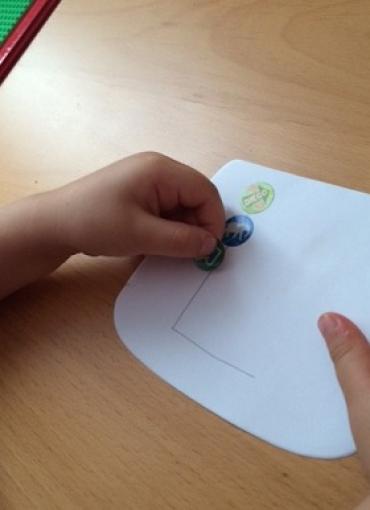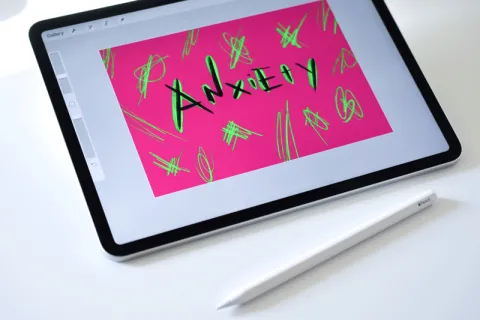Autism and learning to write
Our child won’t look at the paper
By Desiree Gapultos, Occupational TherapistThis response is by occupational therapist Desiree Gapultos, who practices in the Autism Speaks Autism Treatment Network, at Children's Hospital Los Angeles.
Our son is 4 years old and has autism. How can I help him learn to write when he doesn't make good eye contact with the paper?
Autism and writing
Thank you for your question. It’s very apt as visual attention is one of several foundation skills we need to write. Other important pre-writing skills include visual-motor integration (hand-eye coordination) and fine motor skills. A child also needs to grasp the concept that we can use a writing implement to make deliberate shapes and marks on a writing surface (versus just scribbling).
I’m glad to offer some tips based on my experience working with many young children on the autism spectrum. First, I want to emphasize that 4 years old is too young to expect a child to write clear letters – regardless of whether the child has autism. Rather, the goal should be encouraging your son to copy basic shapes and trace some letters.
Helping to develop pre-writing skills
So let's start with the challenge you describe – getting your son to focus on the writing paper. Overall, I recommend tapping into your child’s interests to capture his attention. Does he love cars? Draw a car on a piece of paper and show it to him. Next make circles and explain they are the wheels of the car, etc.
Engaging your son’s attention
- Place a large piece of paper, erasable writing board or chalkboard on an upright surface such as an easel or wall. Put it right at your son’s eye level. Then, give him some colorful markers or crayons and show him how fun it is to draw on the surface in front of him. (I’ve found that standing often helps kids on the spectrum become involved in a task.)
- Grab some colorful pieces of chalk and head outdoors to show your son how to draw on the sidewalk.
Practicing pre-writing skills
Once you’ve found a writing surface that engages your son’s attention, I encourage you to practice some fun, pre-writing skills before moving on to letters.
- Using colorful crayons, markers or chalk, show your son how to draw shapes – circles, a big “X” and zigzags. Encourage him to copy or trace your motions. Or you copy him. If he makes a mark on the sidewalk, praise him and make a mark just like his. Have your child make a circle; then you add the eyes, nose and mouth to make a happy face that you both created together.
- Show your son how to trace his hand on the sidewalk or the writing surface you’ve put on the wall. After tracing your own hand, you might need to use gentle hand-over-hand guidance to show him how to trace his own. Many children in my practice greatly enjoy the sensory aspects of this activity, which encourages visual attention and interest in using a writing tool.
- Show your son how to trace shapes in the sand with his finger or press shapes in soft clay with a stick. These activities can provide enjoyable sensory feedback. In fact, having your child “feel” letters and shapes can help him remember how to draw them later.
Eye-catching cues
Use some visual cues to encourage your son to trace the lines and shapes you draw. This teaches the important concept of making purposeful movements with a writing tool and having a goal with the lines he creates (i.e. moving from scribbling to writing). Here are some options:
- Use a small sticker or inked stamp to highlight the start of the line or shape that you want your child to trace or draw. Place another at the end of the line or shape. Try a series of stickers or shapes and show your son how to connect the dots with a colorful crayon or marker. Give your child some stickers and have him place them along the line of a letter you draw.
- Draw a square and ask your child to make a mark in it. You may need to demonstrate how to do this by placing an “X” in the box.
- Pick up some brightly colored construction paper to attract your child’s attention. Then give him some markers in contrasting colors – for example a blue marker to draw on yellow paper. One caveat: Bright colors can visually overwhelm some children on the autism spectrum. So I encourage you to look for signs of this in your son – for example, an increased tendency to look away from the bright paper.
After your son has had a chance to enjoy these pre-writing activities, you may find that he’s more interested in drawing and tracing letters on a sheet of paper. If not, I suggest consulting with an occupational therapist or educational specialist for additional assessment and suggestions.
For related guidance, also see:
Editor’s note: The above information is not meant to diagnose or treat and should not take the place of personal consultation, as appropriate, with a qualified healthcare professional and/or behavioral therapist.












